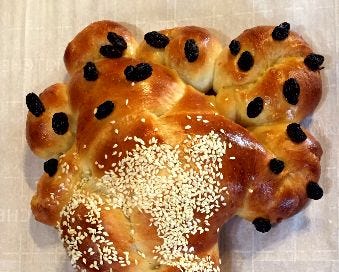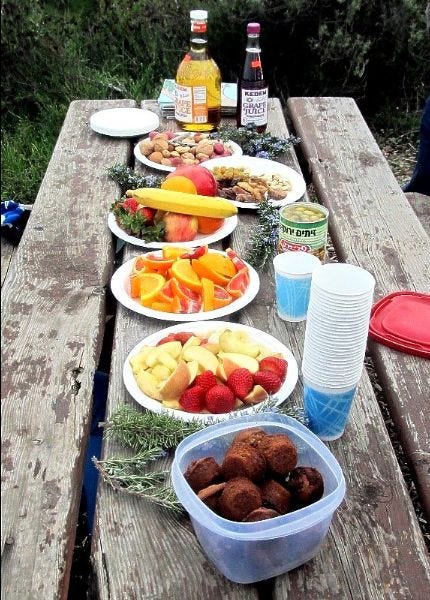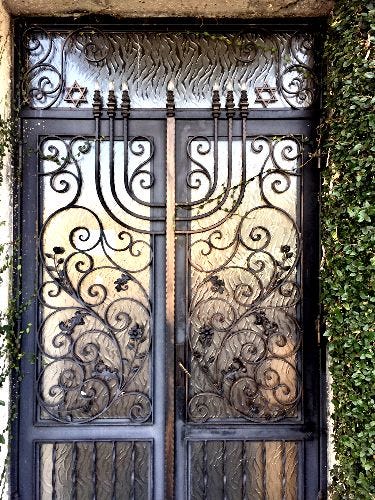January 14, 2022
A New Scroll of LA Jewish News
Folks,
Not far from the Tree of Life, grows challah, our staff of nourishment and celebration (baked by Brenda Rodman). The New Year of Trees, Tu BiShvat, which begins Sunday night, asks us to use our creativity and insight to grow into fresh ways of doing and thinking. Even in drought and pandemic, the trees stand over us, cleaning our air, opening our eyes to beauty, and providing a safe place for birds and squirrels. Adding sustenance to our tables, trees are a blessing. (And how would we wake up without leaf blowers?)
In this season too, you can keep MegilLA green and growing with a paid subscription. It’s time you pitched in.
Shabbat shalom
Edmon J. Rodman
////\/\\\\
Breathing Green with a Tu BiShvat seder
Edmon J. Rodman
In this season of surge, it’s still a good time to step outside to spend some time with our trees. Tu BiShvat, the New Year of the Trees is on Monday, January 17, and if you have a spot nearby with a tree or two, you can take in their beauty and recognize the importance they have in our lives, by celebrating them with an outdoor seder.
This is no ordinary picnic. For the seder you will need a guide, a Haggadah and “Branching Out” by the Jewish National Fund provides a good, easy-to-use explanatory text.
For the table, you will also need specific types of fruit and nuts, each representative of one of the four different levels of existence that the Kabbalists of Tzvat, who created the seder, taught that we live on simultaneously: Assiyah, doing, Yetzirah, formation, Briyah, creation, and Atzilut, nobility. For example, Assiyah, actions like repairing the world, are represented by fruits and nuts with a tough outer shell and a soft inside like walnuts or pomegranates to remind us of our physical exteriors and our inner spiritual lives.
You will also need two different colors of wine or juice to mix, the change in color representing the progression of changes in season.
To add context to your seder, Livnot U’Lehibanot, “To build and to be built,” has a “Tu B’Shvat Companion.” One chapter relates how the Jewish value of “inclusiveness” can be “extracted” from the palm tree. “The palm tree has nothing wasted from it,” the dates are eaten, young unopened branches are used at Sukkot for the lulav, the trunk fibers are “used to make rope.” The “people of Israel have no person wasted,” concludes this section.
Each of the seven species found in Israel is presented within the context of a physical and spiritual connection; the olive tree with multiple trunks like a family, wheat, with our ability, even during a pandemic, to grow, change and improve.
////\/\\\\
For Martin Luther King Jr. Day,
a short video I wrote and narrated last year about the long, complicated, and often fulfilling relationship between LA’s Blacks and Jews, can be viewed HERE, at the 11-minute mark. It was shown as part of the live-streaming of “If Not Now,” a multicultural interfaith tribute to Dr. King produced by Craig Taubman.
////\/\\\\
Anti-Semitic flyers
that attempt to link Jewish people with the anti-vaccine movement were discovered at five elementary and two middle schools in Santa Monica on Thursday morning, said spokesperson for Santa Monica-Malibu Unified School District. The incident was similar to other incidents reported across Los Angeles County.The fliers feature what appears to be a red-and-green Star of David with the phrase “anti-vaxxer” written on it in white block letters.During the pandemic, Jewish organizations such as the Los Angeles Jewish Federation Council have organized vaccine information portals, where Angelenos can seek out information and make vaccine appointments.
////\/\\\\
Step into the light of LA Jewish history
Providing a bright backdrop for the beginning of awards season, the historic neon lights of LA’s Broadway glow with the little-known story of the city’s Jewish history. Many of street’s 12 movie theaters, debuted films that changed motion picture history, like the Tower Theater's screening of the ground-breaking talkie, the "Jazz Singer."
Demonstrating that Jews contributed to the early days of the film business in unexpected ways, many of the street's movie palaces were designed by Jewish architects like G. Albert Lansburgh, or conceived by Jewish showmen, like Sid Grauman.
Other historic buildings found on Broadway were the homes of Jewish-owned department stores, men’s and women’s clothing shops, jewelry stores, food markets, and cigar stands.
Over the last year, I have been collecting artifacts of Broadway’s past, researching and walking the street, getting a feel for the Jewish life that once flourished there. To share that work with you, I will be leading a walking tour of the street called “Jewish Lights Over Broadway" on Sunday, January 16 from 7 to 9 p.m.
The tour, organized with the Museum of Neon Art in Glendale, the tour (RESERVATIONS REQUIRED, make them HERE) illuminates how the Jewish entrepreneurs of Broadway, many of them immigrants, filled the street with bright lights, and the city’s homes with music, the latest in fashion, and the staples required to satisfy a hungry, growing city.
////\/\\\\
Seen On the Way: Pico-Robertson
The wrought iron gates of the Pinto Center on 8660 W. Pico Boulevard, greet passersby with the form of curling branches, flowers and leaves, suggestive of the Tree of Life and Tu BiShvat. The building is the home of Beit-El Yeshiva, which describes itself as a “Community of Jews of all walks of life.” The Center is named after the Pinto family tzaddikim, a lineage of Torah scholars with roots in the Golden Age of Spanish Jewry.
////\/\\\\











Thank you, Edmon, for your continuing, and fascinating, reporting. Your posts are terrific and a joy to read. Thanks also to Brenda for her amazing and beautiful baking!